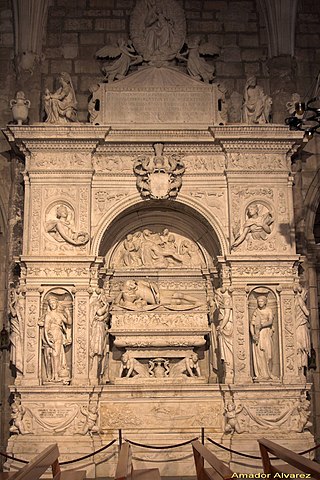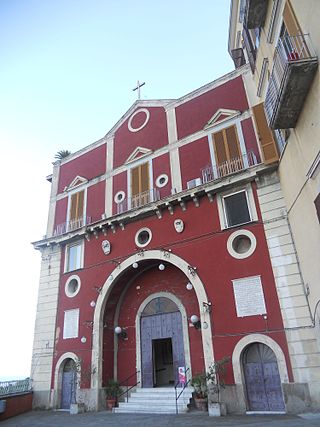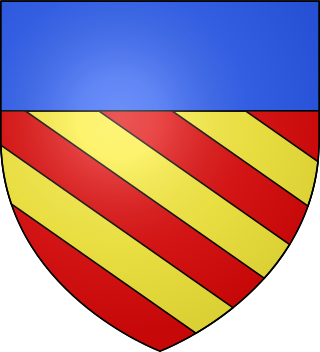
Muzio Attendolo Sforza was an Italian condottiero. Founder of the Sforza dynasty, he led a Bolognese-Florentine army at the Battle of Casalecchio.

Joanna II was reigning Queen of Naples from 1414 to her death, when the Capetian House of Anjou became extinct. As a mere formality, she used the title of Queen of Jerusalem, Sicily, and Hungary.

The Denial of Saint Peter(La Negazione di Pietro) is a painting finished around 1610 by the Italian painter Caravaggio. It depicts Peter denying Jesus after Jesus was arrested. The painting is housed in the Metropolitan Museum of Art in New York City.

Giovanni Battista Caracciolo (1578–1635) was an Italian artist and important Neapolitan follower of Caravaggio. He was a member of the murderous Cabal of Naples, with Belisario Corenzio and Giambattista Caracciolo, who were rumoured to have poisoned and disappeared their competition for painting contracts.

Giovanni Caracciolo, often called Sergianni, was an Italian nobleman of the Kingdom of Naples, prime minister and favorite of queen Joan II of Naples.

Santa Maria la Nova is a Renaissance style, now-deconsecrated, Roman Catholic church and monastery in central Naples. The church is located at the beginning of a side street directly across from the east side of the main post office, a few blocks south of the Church and Monastery of Santa Chiara. Today the adjacent monastery is a meeting site and hosts the Museo ARCA of modern religious art.

San Giovanni a Carbonara is a Gothic church in Naples, Southern Italy. It is located at the northern end of via Carbonara, just outside what used to be the eastern wall of the old city. The name carbonara was given to this site allocated for the collection and burning of refuse outside the city walls in the Middle Ages.

Jacopo Caldora or Giacomo Caldora was an Italian condottiero.

Ferdinando Sanfelice was an Italian late Baroque architect and painter.
Gennaro di Cola was an Italian painter of the Trecento, active mainly in Naples.

Giovanni da Nola (1478–1559), also known as Giovanni Merliano, was an Italian sculptor and architect of the Renaissance, active in Naples.
Annibale Caccavello (1515–1595) was an Italian sculptor of the Renaissance, active in his native city of Naples.

Christianity and religion in general has always been an important part of the social and cultural life of Naples. It is the seat of the Archdiocese of Naples, and the Catholic faith is highly important to the people of Naples and there are hundreds of historic churches in the city. The Cathedral of Naples is the most important place of worship in the city, each year on September 19 it hosts the Miracle of Saint Januarius, the city's patron saint. In the miracle which thousands of Neapolitans flock to witness, the dried blood of Januarius is said to turn to liquid when brought close to relics said to be of his body: this is one of the most important traditions for Neapolitans.

The Royal Chapel of the Treasure of St. Januarius, or the Reale cappella del Tesoro di San Gennaro, is a chapel located in the Cathedral of Naples, Italy, and dedicated to St. Januarius, patron saint of the city. This is the most lavishly decorated chapel in the cathedral, and contains contributions by the premier Baroque artists in Naples.

The church of Santi Severino e Sossio and the annexed monastery are located on via Bartolommeo Capasso in Naples, Italy.

Santa Maria del Parto a Mergellina is a church located in the quartiere of Chiaia in Naples, Italy. The church is peculiarly perched on top of a private building and accessed by a stairway, placed behind a restaurant located in piazza Mergellina.

The House of Caracciolo is a prominent aristocratic noble family that originated in the city of Naples. The Caracciolos are considered one of the most important families in the history of the Kingdom of Naples, and also held relevant posts in the Spanish Empire, Holy Roman Empire, and the Roman Catholic Church.

Giovanni da Gaeta was an Italian painter active in the late-Gothic period in Campania and his native Gaeta. Little details are known about his life. An altarpiece of the Assunzione found in San Giovanni a Carbonara in Naples is attributed to him. He may have been influenced by Leonardo da Besozzo or Pisanello, during their stays in Naples.

Leonardo Da Besozzo or Leonardo Dei Molinari was an Italian painter, active in Lombardy and Naples.
San Biagio is a Roman Catholic church and monastery in the municipality of Aversa, province of Caserta, in the region of Campania, southern Italy.

















